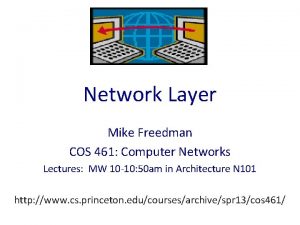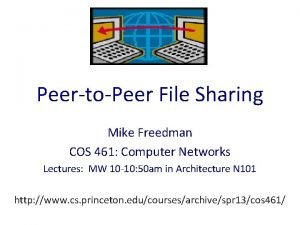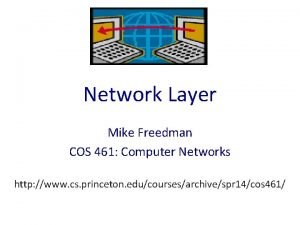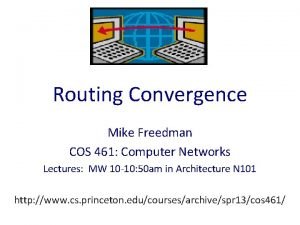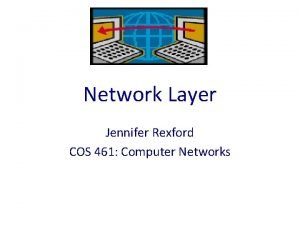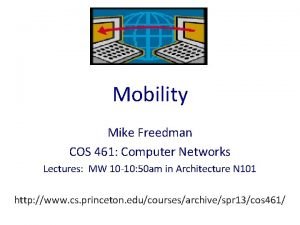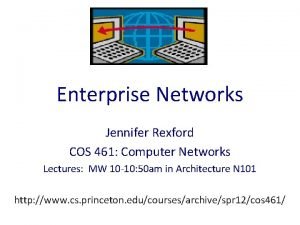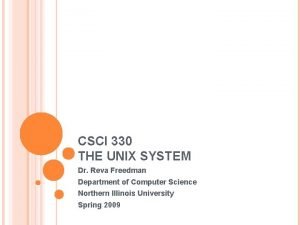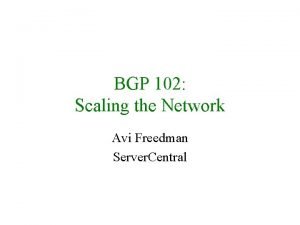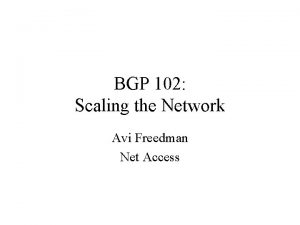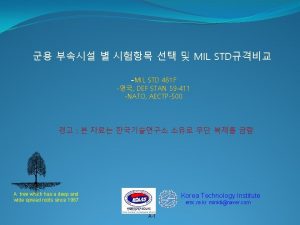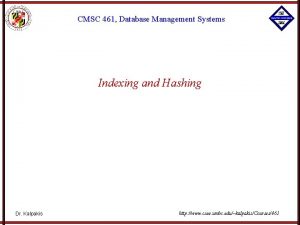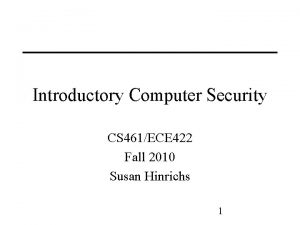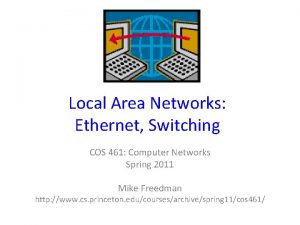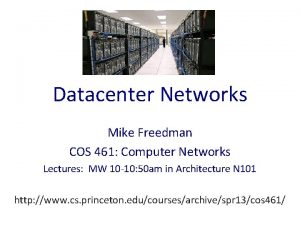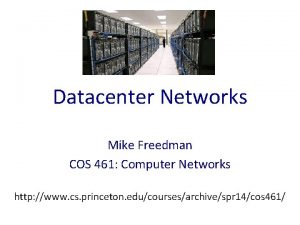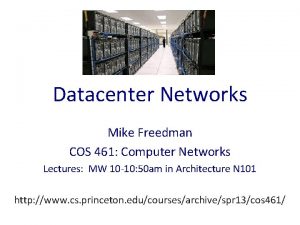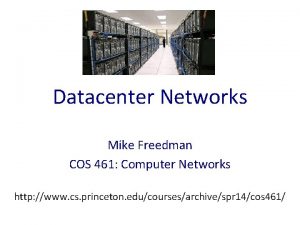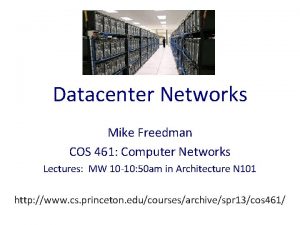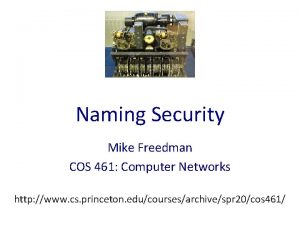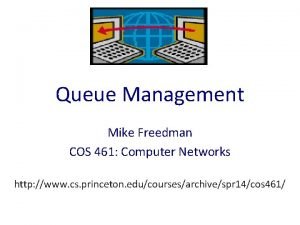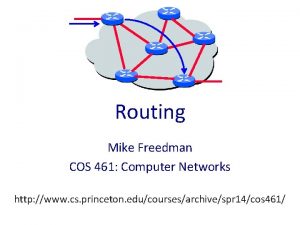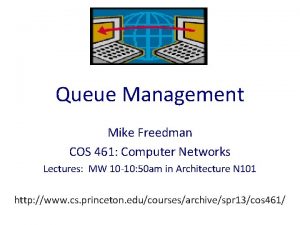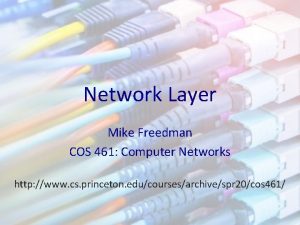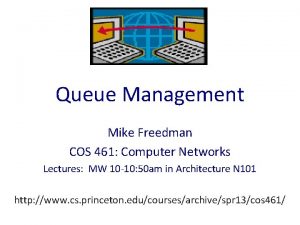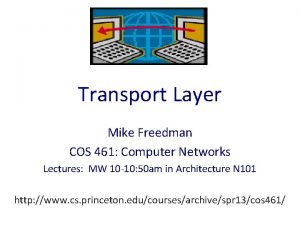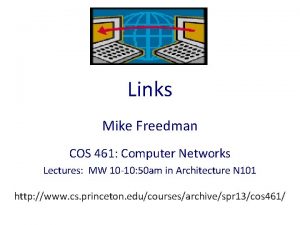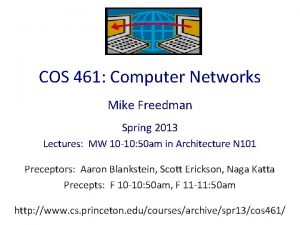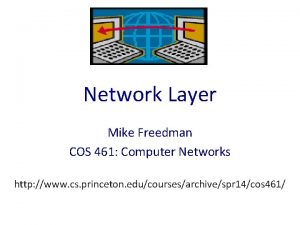Communication Security Mike Freedman COS 461 Computer Networks







































- Slides: 39

Communication Security Mike Freedman COS 461: Computer Networks http: //www. cs. princeton. edu/courses/archive/spr 20/cos 461/

2 Internet’s Design: Insecure • Designed for simplicity • “On by default” design • Readily available zombie machines • Attacks look like normal traffic • Internet’s federated operation obstructs cooperation for diagnosis/mitigation

Eavesdropping - Message Interception (Attack on Confidentiality) • Unauthorized access to information • Packet sniffers and wiretappers (e. g. tcpdump) • Illicit copying of files and programs A B Eavesdropper 3

4 Integrity Attack - Tampering • Stop the flow of the message • Delay and optionally modify the message • Release the message again A B Perpetrator

5 Authenticity Attack - Fabrication • Unauthorized assumption of other’s identity • Generate and distribute objects under identity A B Masquerader: from A

6 Attack on Availability • Destroy hardware (cutting fiber) or software • Modify software in a subtle way • Corrupt packets in transit A B • Blatant denial of service (Do. S): – Crashing the server – Overwhelm the server (use up its resource)

7 Basic Security Properties • Confidentiality: Concealment of information or resources • Authenticity: Identification and assurance of origin of info • Integrity: Trustworthiness of data/resources; preventing improper and unauthorized changes • Availability: Ability to use desired information or resource • Non-repudiation: Offer of evidence that a party indeed is sender or a receiver of certain information • Access control: Facilities to determine and enforce who is allowed access to what resources (host, software, network, …)

8 Security protocols at many layers • Application layer – E-mail: PGP, using a web-of-trust – Web: HTTP-S, using a certificate hierarchy • Transport layer – Transport Layer Security/ Secure Socket Layer • Network layer – IP Sec • Network infrastructure – DNS-Sec and BGP-Sec

9 Introduction to Cryptography

10 Cryptographic Algorithms: Goal • One-way functions: cryptographic hash – Easy to compute hash – Hard to invert • “Trapdoor” functions: encryption/signatures – Given ciphertext alone, hard to compute plaintext (invert) – Given ciphertext and key (the “trapdoor”), relatively easy to compute plaintext – “Level” of security often based on “length” of key

11 Encryption and MAC/Signatures Confidentiality (Encryption) Auth/Integrity (MAC / Signature) Sender: • Compute C = Enc. K(M) • Send C Receiver: • Recover M = Dec. K(C) Sender: • Compute s = Sig. K(Hash (M)) • Send <M, s> Receiver: • Compute s’ = Ver. K(Hash (M)) • Check s’ == s These are simplified forms of the actual algorithms

Symmetric vs. Asymmetric Crypto a. k. a. Secret vs. Public Key Crypto • Symmetric crypto (all crypto pre 1970 s) – Sender and recipient share a common key – All classical encryption algorithms are private-key – Dual use: confidentiality or authentication/integrity • Encryption vs. msg authentication code (MAC) • Public-key crypto – – (Public, private) key associated with each entity (“Alice”) Anybody can encrypt to Alice, anybody can verify Alice’s msg Only Alice can decrypt, only Alice can “sign” Developed to address “key distribution” problem and “digital signatures” (w/o prior establishment) 12

13 Why still both? • Symmetric Pros and Cons – Simple and very fast (1000 -10000 x faster than asymmetric) – Must agree/distribute the key beforehand – AES/CBC (256 -bit) 80 MB/s (for 2048 bits, that’s. 003 ms) • Public Key Pros and Cons – Easier key pre-distribution: “Public Key Infrastructure” (PKI) – Much slower – 2048 -RSA 6. 1 ms Decrypt, 0. 16 ms Encrypt • Common “engineering” approach: – Best of both worlds via “hybrid” scheme: Use public key to distribute a new random ”session” key b/w sender and recipient, then symmetric crypto for remainder of session

14 Email Security: Pretty Good Privacy (PGP)

15 Sender and Receiver Keys • If the sender knows the receiver’s public key • If the receiver knows the sender’s public key – Confidentiality – Receiver authentication – Sender non-repudiation

16 Sending an E-Mail Securely • Sender digitally signs the message – Using the sender’s private key • Sender encrypts the data – Using a one-time session key – Sending the session key, encrypted with the receiver’s public key • Sender converts to an ASCII format – Converting the message to base 64 encoding – (Email messages must be sent in ASCII)

17 Public Key Certificate • Binding between identity and a public key – “Identity” is, for example, an e-mail address – “Binding” ensured using a digital signature • Contents of a certificate – Identity of the entity being certified – Public key of the entity being certified – Identity of the signer – Digital signature algorithm id

18 Web of Trust for PGP • Decentralized solution – Protection against government intrusion – No central certificate authorities • Customized solution – Individual decides whom to trust, and how much – Multiple certificates with different confidence levels • Key-signing parties! – Collect and provide public keys in person – Sign other’s keys, and get your key signed by others

19 HTTP Security

20 HTTP Threat Model • Eavesdropper – Listening on conversation (confidentiality) • Man-in-the-middle – Modifying content (integrity) • Impersonation – Bogus website (authentication, confidentiality)

21 HTTP-S: Securing HTTP • HTTP sits on top of secure channel (SSL/TLS) – https: // vs. http: // – TCP port 443 vs. 80 • All (HTTP) bytes encrypted and authenticated HTTP Secure Transport Layer TCP IP – No change to HTTP itself! • Where to get the key? ? ? Link layer

22 Learning a Valid Public Key • What is that lock? – Securely binds domain name to public key (PK) • If PK is authenticated, then any message signed by that PK cannot be forged by non-authorized party – Believable only if you trust the attesting body • Bootstrapping problem: Who to trust, and how to tell if this message is actually from them?

23 Hierarchical Public Key Infrastructure • Public key certificate – Binding between identity and a public key – “Identity” is, for example, a domain name – Digital signature to ensure integrity • Certificate authority – Issues public key certificates and verifies identities – Trusted parties (e. g. , Veri. Sign, Go. Daddy, Comodo) – Preconfigured certificates in Web browsers

24 Public Key Certificate

25

26

27 Transport Layer Security (TLS) Based on the earlier Secure Socket Layer (SSL) originally developed by Netscape

28 TLS Handshake Protocol • Send new random value, list of supported ciphers • Send pre-secret, encrypted under PK • Send new random value, digital certificate with PK • Create shared secret key from pre-secret and random • Switch to new symmetrickey cipher using shared key

29 TLS Record Protocol • Messages from application layer are: – Fragmented or coalesced into blocks – Optionally compressed – Integrity-protected using an HMAC – Encrypted using symmetric-key cipher – Passed to the transport layer (usually TCP) • Sequence #s on record-protocol messages – Prevents replays and reorderings of messages

30 Comments on HTTPS • HTTPS authenticates server, not content – If CDN (Akamai) serves content over HTTPS, customer must trust Akamai not to change content • Symmetric-key crypto after public-key ops – Handshake protocol using public key crypto – Symmetric-key crypto much faster (100 -1000 x) • HTTPS on top of TCP, so reliable byte stream – Can leverage fact that transmission is reliable to ensure: each data segment received exactly once – Adversary can’t successfully drop or replay packets

31 IP Security

32 IP Security • There are range of app-specific security mechanisms – eg. TLS/HTTPS, S/MIME, PGP, Kerberos, … • But security concerns that cut across protocol layers • Implement by the network for all applications? Enter IPSec!

33 IPSec • General IP Security framework • Allows one to provide – Access control, integrity, authentication, originality, and confidentiality • Applicable to different settings – Narrow streams: Specific TCP connections – Wide streams: All packets between two gateways

34 IPSec Uses

35 Benefits of IPSec • If in a firewall/router: – Strong security to all traffic crossing perimeter – Resistant to bypass • Below transport layer – Transparent to applications – Can be transparent to end users • Can provide security for individual users

36 IP Security Architecture • Specification quite complex – Mandatory in IPv 6, optional in IPv 4 • Two security header extensions: – Authentication Header (AH) • Connectionless integrity, origin authentication – MAC over most header fields and packet body • Anti-replay protection – Encapsulating Security Payload (ESP) • These properties, plus confidentiality

37 Encapsulating Security Payload (ESP) • Transport mode: Data encrypted, but not header – After all, network headers needed for routing! – Can still do traffic analysis, but is efficient – Good for host-to-host traffic • Tunnel mode (“IP-in-IP”) – Encrypts entire IP packet – Add new header for next hop – Good for VPNs, gateway-to-gateway security

38 Replay Protection is Hard • Goal: Eavesdropper can’t capture encrypted packet and duplicate later – Easy with TLS/HTTP on TCP: Reliable byte stream – But IP Sec at packet layer; transport may not be reliable • IP Sec solution: Sliding window on sequence #’s – All IPSec packets have a 64 -bit monotonic sequence number – Receiver keeps track of which seqno’s seen before • [lastest – windowsize + 1 , latest] ; windowsize typically 64 packets – Accept packet if • seqno > latest (and update latest) • Within window but has not been seen before – If reliable, could just remember last, and accept iff last + 1

39 Conclusions • Security at many layers – Application, transport, and network layers – Customized to the properties and requirements • Exchanging keys – Public key certificates – Certificate authorities vs. Web of trust • Next time – Naming security • Learn more: take COS 432 next year!
 Cos 461
Cos 461 Cos 461
Cos 461 Cos 461
Cos 461 Cos 461
Cos 461 Cos 461
Cos 461 Cos 461
Cos 461 Cos 461
Cos 461 Cos 461
Cos 461 Cos 461
Cos 461 Cos 461
Cos 461 Cos 461
Cos 461 Virtual circuit tables
Virtual circuit tables Backbone networks in computer networks
Backbone networks in computer networks Security security security
Security security security Young and freedman
Young and freedman Current resistance and electromotive force
Current resistance and electromotive force Sears zemansky
Sears zemansky Danielle freedman
Danielle freedman Rabbi david freedman
Rabbi david freedman Neil freedman
Neil freedman Steve freedman
Steve freedman 461 enneagram
461 enneagram Csci 330
Csci 330 Avi freedman
Avi freedman Avi freedman net worth
Avi freedman net worth Mil-std-10
Mil-std-10 Cmsc 461
Cmsc 461 Uiuc cs 461
Uiuc cs 461 Cs 461
Cs 461 Ccna voice 640-461 pdf
Ccna voice 640-461 pdf Kkk 461
Kkk 461 Opwekking 461 tekst
Opwekking 461 tekst Mil-std-464a
Mil-std-464a Icvm 461/07
Icvm 461/07 Area 461
Area 461 Ece 422 uiuc
Ece 422 uiuc Celebrated on march 17
Celebrated on march 17 Opwekking 461
Opwekking 461 Contul 4427
Contul 4427 Palo alto networks next generation security platform
Palo alto networks next generation security platform

